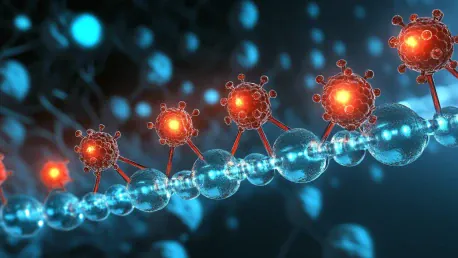The groundbreaking study conducted by researchers Yang Zhang, PhD, and Jinjun Shi, PhD, from Brigham and Women’s Hospital, offers promising insights into the potential of RNA nanoparticles in treating advanced prostate cancer (PCa). Their research focuses on a dual-action strategy involving the simultaneous delivery of messenger RNA (mRNA) and small interfering RNA (siRNA) to cancer cells. By targeting key molecules involved in tumor growth and suppression, the team sought to address the critical imbalance seen in cancerous cells and thereby halt their progression.
Dual-Action Strategy
Restoring Tumor Suppressor PTEN
In prostate cancer, the loss of the tumor suppressor PTEN is a common occurrence, leading to uncontrolled cell growth. To counteract this, Zhang and Shi’s research employed mRNA to restore PTEN levels within cancer cells. By replenishing this crucial protein, the researchers aimed to rebalance the cell’s regulatory mechanisms that typically prevent tumor formation. This approach leverages the natural cellular machinery to produce PTEN, thus reinstating its tumor-suppressing functions. The successful restoration of PTEN could prevent further cellular mutations that often lead to aggressive cancer growth and metastasis.
The mRNA delivery component forms the first pillar of the dual-action strategy, representing a significant advancement in the therapeutic reintroduction of proteins lost during cancer progression. By using mRNA encoding for PTEN, the approach capitalizes on the cell’s ability to translate mRNA into functional protein, effectively fighting off the disease at a molecular level. The promising preclinical results indicate that this method could potentially lay the foundation for more comprehensive cancer treatments, offering hope to patients with limited options.
Silencing Tumorigenic Driver AR
On the other hand, the overexpression of the androgen receptor (AR) is a key driver in prostate cancer, contributing to tumor growth and resistance to conventional therapies. To target this, the researchers incorporated siRNA, which is a molecule capable of interfering with AR expression. The siRNA binds to the AR mRNA, marking it for degradation and thereby reducing the levels of the AR protein in the cells. This process directly impacts the cancer cell’s ability to proliferate, addressing a crucial aspect of tumor progression and resistance.
Integrating siRNA into the therapeutic framework aims to complement the mRNA-based restoration of PTEN. By simultaneously silencing the tumorigenic driver AR, this approach provides a multifaceted strategy to halt the progression of PCa. The significant reduction in AR levels observed in preclinical models emphasizes the potential efficacy of siRNA in treating hormone-resistant and advanced stages of the cancer. Combining these two molecular strategies forms a robust therapeutic guard against prostate cancer’s relentless progression.
Delivery Mechanism and Broader Applications
Lipid Nanoparticles
The effectiveness of the dual-action RNA strategy hinges on the efficient delivery of mRNA and siRNA to the cancer cells. Zhang and Shi utilized lipid nanoparticles, a cutting-edge delivery system that facilitates the passage of RNA molecules into the target cells. These lipid particles encapsulate the RNA, protecting it from degradation and ensuring its stability as it navigates through the bloodstream. Upon reaching the tumor site, the nanoparticles merge with the cell membrane, releasing the RNA payload into the cancerous cells, where it can exert its therapeutic effect.
Lipid nanoparticles have gained significant attention in the field of nanomedicine due to their biocompatibility and ability to deliver genetic material with high precision. The successful application of lipid nanoparticles in this study not only underscores their potential in advanced prostate cancer therapy but also points towards their broader utility across various types of cancer. The versatility of these nanoparticles could revolutionize RNA-based treatments, enabling the targeting of a wide array of genetic aberrations found in malignant tumors.
Broader Applications Beyond PCa
While the focus of Zhang and Shi’s research was on prostate cancer, the implications of their findings extend far beyond a single cancer type. The dual-action RNA strategy could be adapted to target other malignancies characterized by similar molecular imbalances. For instance, breast cancer, non-small cell lung cancer, and hepatocellular carcinoma—all of which exhibit aberrant protein expression and loss of critical tumor suppressors—could potentially benefit from this innovative approach. By customizing the RNA payloads to address the specific genetic alterations found in each cancer type, researchers could develop personalized treatments that offer heightened efficacy and fewer side effects.
The potential to extend this RNA nanoparticle therapy to other cancers represents a significant leap forward in oncological treatment strategies. As the research progresses, further insights into the mechanisms of action and biological interactions of these RNA molecules will be pivotal. Understanding these processes will allow for the optimization of RNA nanoparticle therapies and identification of new therapeutic targets, paving the way for novel treatments that could improve survival rates and quality of life for cancer patients worldwide.
Future Directions and Clinical Prospects
Biological Mechanisms and Therapeutic Targets
The promising preclinical results invite further investigation into the biological mechanisms underlying the combined effects of mRNA and siRNA in cancer therapy. Delving deeper into how these molecules interact within the cellular environment could uncover additional therapeutic targets and enhance the efficacy of the treatment. By understanding the pathways and regulatory processes influenced by the RNA particles, researchers can refine the approach to maximize its therapeutic potential. This knowledge could also lead to the discovery of biomarkers that predict patient response, enabling more personalized and effective treatment plans.
The study’s framework provides a template for exploring the potential of RNA nanoparticle therapy across a spectrum of cancers. The dual-action strategy holds particular promise for malignancies with complex molecular landscapes, where single-target therapies often fall short. By simultaneously addressing multiple hallmarks of cancer, this approach strives to offer comprehensive solutions that outpace the adaptability and resilience of cancer cells, seeking to offer long-term remission and potentially curative outcomes.
Clinical Trials and Optimization
The pioneering research conducted by Yang Zhang, PhD, and Jinjun Shi, PhD, from Brigham and Women’s Hospital, has unveiled promising prospects for using RNA nanoparticles to treat advanced prostate cancer (PCa). This study investigates a dual-action approach that involves the concurrent delivery of messenger RNA (mRNA) and small interfering RNA (siRNA) to cancer cells. By simultaneously targeting critical molecules that are responsible for tumor growth and suppression, the researchers aim to correct the significant imbalance present in cancerous cells, potentially halting their progression. This exploration into RNA-based therapies highlights a novel method that could significantly impact how advanced prostate cancer is managed and treated. By addressing both growth-promoting and growth-inhibiting pathways within the cancer cells, the research offers a comprehensive approach that could pave the way for new treatments, offering hope for better outcomes in PCa patients. This study stands as a testament to the innovative strides being made in the realm of cancer research and therapeutic development.









